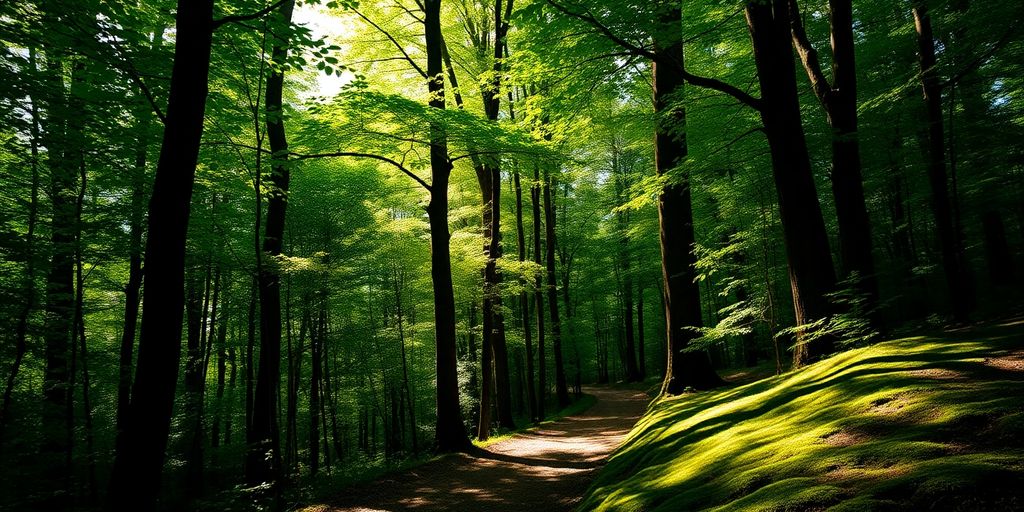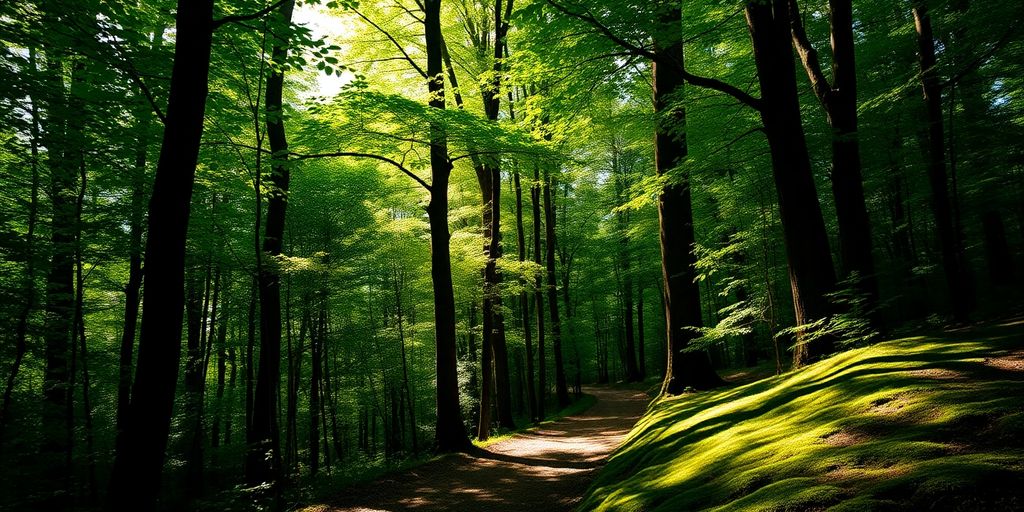Exploring the Benefits of Shinrin-yoku: The Art of Japanese Forest Bathing

Ever heard of Shinrin-yoku? It’s a Japanese thing, but it’s catching on everywhere. Basically, it’s about hanging out in the woods, taking it all in, and just chilling out. People say it’s good for you, both in body and mind. It’s not about hiking or anything intense—just being there. Let’s dive into what makes this practice so special and why folks are loving it.
Key Takeaways
- Shinrin-yoku, or forest bathing, originated in Japan in the 1980s and is all about connecting with nature.
- This practice is linked to numerous health benefits, including stress reduction and improved mood.
- Unlike hiking, Shinrin-yoku focuses on slow, mindful immersion in nature, engaging all the senses.
- Forest bathing is gaining popularity worldwide, with adaptations in various cultures.
- The practice encourages conservation and a deeper appreciation for natural spaces.
Understanding Shinrin-yoku
Origins and Cultural Significance
Shinrin-yoku, or forest bathing, is a Japanese practice that encourages individuals to immerse themselves in nature through their five senses, promoting stress reduction and overall well-being. It was developed in the 1980s as a response to the increasing urbanization and technological stress in society. This practice is deeply rooted in Shinto and Buddhist traditions, which emphasize the importance of nature in spiritual and physical health. Simply put, it’s about slowing down and soaking in the forest atmosphere.
Scientific Basis and Research
Scientific studies began in the 1990s, focusing on the physiological and psychological benefits of forest bathing. Research shows significant reductions in cortisol levels, which is a stress hormone, and improvements in immune function. Biometrics such as white blood cell counts and anti-cancer proteins like granulysin have shown positive changes after engaging in Shinrin-yoku. These findings have been replicated in various studies worldwide, highlighting the universal benefits of nature immersion.
Comparison with Western Practices
While Western practices like mindfulness and meditation share similarities with Shinrin-yoku, there are key differences. Western approaches often emphasize mental exercises and structured techniques, whereas forest bathing is more about passive, sensory engagement with the environment. In essence, Shinrin-yoku is less about achieving a mental state and more about experiencing the natural world through your senses. This practice can be easily adapted to Western settings, whether in a dense forest or a city park, making it accessible to many.
Health Benefits of Forest Bathing
Physical Health Improvements
Forest bathing isn’t just a walk in the park; it’s a full-body experience that can lead to real physical health improvements. Spending time in nature can help lower blood pressure and reduce the risk of heart disease. When you walk among the trees, your body gets a workout, but it’s gentle and easy on the joints. Plus, being in nature encourages more physical activity than just sitting indoors. Regular forest bathing can also improve your sleep patterns, helping you feel more rested and energetic.
Mental Health Enhancements
The mental health benefits of forest bathing are significant. When you’re surrounded by the soothing sounds of nature, your stress levels drop, and your mind can truly relax. This practice has been linked to reduced anxiety and improved mood. It’s like hitting the reset button on your brain. Forest bathing offers significant mental health benefits, including enhanced mindfulness, which helps you stay present and focused in your daily life. It’s a natural way to boost your emotional well-being without needing any special equipment or training.
Boosting Immunity Through Nature
Believe it or not, forest bathing can actually give your immune system a boost. Trees release phytoncides, which are natural oils that have antimicrobial properties. When you breathe in these oils, they can increase your body’s natural killer cell activity, helping you fight off infections more effectively. A regular dose of nature might be just what you need to stay healthy during cold and flu season. It’s a simple, natural way to support your body’s defenses without popping pills or taking supplements.
Spending time in nature isn’t just about feeling good in the moment—it’s about building a foundation for long-term health. When you make forest bathing a regular part of your routine, you’re investing in your physical and mental well-being, setting yourself up for a healthier, happier life.
Practicing Shinrin-yoku

Choosing the Right Location
When it comes to Shinrin-yoku, or forest bathing, picking the perfect spot is key. You don’t need to trek into the wilderness; even urban parks with lots of trees can do the trick. Think about places where you can truly immerse yourself in nature without distractions. Look for areas with varied plant life, water features, or even just a quiet corner where you can hear the rustle of leaves. The main thing is to find a spot where you feel at ease and connected to the natural world.
Guided vs. Solo Experiences
Deciding between a guided session and going solo depends on what you’re after. Guided experiences can offer structure and insights, especially if you’re new to forest bathing. A guide can help you focus on engaging all your senses and might introduce you to techniques you hadn’t considered. On the other hand, going solo allows for a more personal and flexible experience. You set your own pace and follow your instincts, which can be incredibly freeing and personal.
Incorporating Mindfulness Techniques
Bringing mindfulness into your Shinrin-yoku practice is all about being present. Start by taking slow, deep breaths and focus on each one. Feel the air fill your lungs and then release it slowly. As you walk, pay attention to the sensations under your feet, the scents in the air, and the textures you can touch. You might want to stop occasionally to just listen to the sounds around you. This mindful approach not only enhances your connection with nature but also amplifies the stress-reducing benefits of the practice.
Letting go of distractions and truly being in the moment is what makes Shinrin-yoku a transformative experience. It’s about tuning into the world around you and finding peace in the simplicity of nature.
Environmental Impact of Forest Bathing

Promoting Conservation Efforts
Shinrin-yoku, or forest bathing, has a unique way of connecting people to the natural world, which can lead to increased conservation efforts. When individuals spend time in nature, they often develop a deeper appreciation for it, making them more likely to support conservation initiatives. This connection can spark a desire to protect and preserve natural spaces for future generations. Forest bathing encourages people to become advocates for the environment, often leading to volunteer work, donations to conservation organizations, or simply spreading awareness about the importance of preserving natural habitats.
Sustainable Tourism Practices
As forest bathing gains popularity, it is essential to consider its impact on tourism. Sustainable tourism practices are crucial to ensure that the natural environments used for forest bathing are not harmed. This involves:
- Limiting the number of visitors to sensitive areas to prevent overuse and degradation.
- Educating participants on "leave no trace" principles to minimize their environmental footprint.
- Encouraging local communities to participate in and benefit from forest bathing tourism, ensuring that economic benefits support conservation efforts.
Connecting People with Nature
Forest bathing provides a simple yet profound way to reconnect with nature, especially in a world where urbanization is on the rise. By regularly engaging in forest bathing, individuals can experience a sense of belonging to the natural world, which can lead to healthier lifestyles and a greater commitment to environmental stewardship. This connection is not just beneficial for personal well-being but also fosters a community of nature enthusiasts who prioritize the health of our planet.
As more people embrace forest bathing, the ripple effect on environmental awareness and action becomes more evident. The practice not only nurtures individual well-being but also cultivates a collective responsibility to care for our natural surroundings.
Shinrin-yoku Around the World
Adoption in Western Countries
Shinrin-yoku, or forest bathing, has made its way across the globe, finding a home in Western countries. People are drawn to the practice for its simple, yet profound way of reconnecting with nature. In places like the United States and Europe, forest therapy guides are becoming more common, offering structured experiences in local parks and woodlands. This practice is not just a trend but a growing movement towards holistic health.
Cultural Adaptations and Variations
As shinrin-yoku spreads, it naturally evolves. Each culture adds its own flavor to the practice. In the U.S., for instance, there’s a focus on mindfulness and meditation during forest walks. Meanwhile, in Europe, some practitioners incorporate elements of local traditions, like Nordic walking or herbal knowledge, into their sessions. These adaptations make forest bathing accessible and relevant to diverse communities.
Global Shinrin-yoku Communities
Around the world, communities are forming around the shared love of forest bathing. These groups often organize events and retreats, fostering a sense of belonging among participants. Some even use social media to connect with others globally, sharing experiences and tips.
"Forest bathing isn’t just about the trees; it’s about the people you meet along the way and the shared journey towards wellness."
These communities highlight the universal appeal of Shinrin-yoku, showing that the need to connect with nature transcends cultural boundaries.
Challenges and Misconceptions
Overcoming Common Barriers
Getting into forest bathing isn’t always a walk in the park. First off, time is a biggie. People are busy, and carving out a chunk of your day to wander in the woods might feel impossible. Then there’s the whole ‘nature isn’t accessible’ thing. Not everyone lives near a forest or even a decent park. Plus, some folks just aren’t into the idea of bugs, dirt, and the unpredictability of the outdoors. Finding the right balance between embracing nature and maintaining comfort can be tricky.
Debunking Myths About Forest Bathing
There’s a lot of noise around what forest bathing is supposed to be. Some think it’s just a fancy term for hiking. Others imagine it as a mystical ritual involving chanting and incense. In reality, it’s about being present in nature, not about how far you walk or what gear you have. Another myth? That it’s only for the super healthy or the spiritual. Nope, forest bathing is for anyone who wants to feel better, mentally and physically.
Addressing Accessibility Issues
Accessibility is a real hurdle. Many natural spaces aren’t set up for people with mobility challenges. This can make forest bathing feel exclusive. There’s also the issue of transportation—getting to a suitable location isn’t always easy without a car. To make forest bathing more inclusive, communities can work on creating more accessible trails and providing transportation options. It’s about making sure everyone can enjoy the healing power of nature, regardless of physical ability or location.
Embracing nature through forest bathing requires breaking down barriers and myths, making it a practice accessible to all who seek its benefits.
Future of Shinrin-yoku
Innovations in Forest Therapy
Imagine a world where technology and nature blend seamlessly to enhance our well-being. That’s the direction forest therapy is heading. Virtual reality (VR) and augmented reality (AR) are becoming tools for experiencing the serenity of forests without leaving urban environments. These technologies simulate the sights and sounds of nature, offering a digital escape into calming forest settings. There’s also an uptick in wearable devices that monitor physiological responses during forest therapy, providing real-time feedback to enhance the experience.
Potential for Urban Integration
Cities are buzzing with life, but they can also be overwhelming. Integrating Shinrin-yoku into urban areas is gaining traction. Urban planners are now considering green spaces not just for aesthetics but as vital components of city life. Rooftop gardens, vertical forests, and pocket parks are popping up, giving city dwellers a taste of nature amidst concrete jungles. These initiatives aim to make forest bathing accessible for everyone, even in the heart of bustling metropolises.
Research and Development Trends
Ongoing research is crucial to understanding the full scope of Shinrin-yoku’s benefits. Studies are diving deeper into how forest environments impact mental health, focusing on stress reduction and mood enhancement. There’s also a growing interest in the physiological benefits of forest bathing, such as boosting immunity and lowering blood pressure. As more data emerges, it will inform best practices and encourage wider adoption of this therapeutic practice.
The future of Shinrin-yoku looks bright, as it continues to adapt and grow, bringing the healing power of nature to more people worldwide. With a blend of technology, urban planning, and scientific research, forest bathing is set to become an integral part of modern life.
Conclusion
In wrapping up our journey into the world of Shinrin-yoku, it’s clear that this practice offers more than just a walk in the woods. It’s about slowing down and letting nature work its magic on us. Whether you’re in a sprawling forest or a small city park, the benefits are there for the taking. From lowering stress to boosting your mood, forest bathing is a simple yet powerful way to reconnect with the natural world. So next time you’re feeling overwhelmed, consider stepping outside and letting the trees do their thing. It’s a small step that can make a big difference.
Frequently Asked Questions
What exactly is Shinrin-yoku?
Shinrin-yoku, also known as forest bathing, is a Japanese practice where you spend time in nature, especially among trees, to relax and feel better. It’s like taking a calming walk in the woods to help your mind and body.
How does forest bathing help our health?
Forest bathing can lower stress, improve mood, and even boost your immune system. Being around trees and nature helps your body relax and feel more energetic.
Can I practice Shinrin-yoku in a city?
Yes, you can practice Shinrin-yoku in city parks or even your backyard. As long as there are trees and plants, you can enjoy the benefits of nature.
Do I need any special equipment for forest bathing?
No special equipment is needed. Just wear comfortable clothes and shoes. The goal is to enjoy nature with all your senses, so you don’t need anything fancy.
Is forest bathing the same as hiking?
No, forest bathing is not the same as hiking. It’s more about slowly walking or sitting in nature and enjoying the environment, rather than exercising or covering a lot of ground.
Can kids do forest bathing?
Absolutely! Kids can enjoy forest bathing too. It’s a great way for them to explore nature, relax, and have fun.








Responses